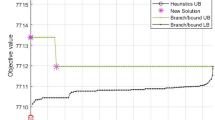Abstract
This study focuses on solving the multi-objective master planning problem for supply chains by considering product structures with multiple final products using substitutions, common components, and recycled components. This study considers five objectives in the planning process: (1) minimizing the delay cost, (2) minimizing the substitution priority, (3) minimizing the recycling penalty, (4) minimizing the substitution cost, and (5) minimizing the cost of production, processing, inventory holding and transportation. This study proposes a heuristic algorithm, called the GA-based Master Planning Algorithm (GAMPA), to solve the supply-chain master planning problem efficiently and effectively. GAMPA first transforms the closed-loop supply chain into an open-loop supply chain that plans and searches the sub-networks for each final product. GAMPA then uses a genetic algorithm to sort and sequence the demands. GAMPA selects the chromosome that generates the best planning result according to the priority of the objectives. GAMPA plans each demand sequentially according to the selected chromosome and a randomly-selected production tree. GAMPA tries different production trees for each demand and selects the best planning result at the end. To show the effectiveness and efficiency of GAMPA, a prototype was constructed and tested using complexity analysis and computational analysis to demonstrate the power of GAMPA.
Similar content being viewed by others
References
Ashley S. (1993) Designing for the environment. Mechanical Engineering 115(3): 52–55
Awadh B., Sepehri N., Hwaaleshka O. (1995) A computer-aided process planning model based on genetic algorithms. Computers & Operations Research 22(8): 841–856
Balakrishnan A., Genunes J. (2000) Requirements planning with substitutions: Exploiting bill-of-materials flexibility in production planning. Manufacturing & Service Operations Management 2(2): 166–185
Beamon B. M. (1998) Supply chain design and analysis: Models and methods. International journal of Production Economics 55(3): 281–294
Brailsford S. C., Potts C. N., Smith B. M. (1999) Constraint satisfaction problems: Algorithms and applications. European Journal of Operational Research 119: 557–581
Chern C. C., Hsieh J. S. (2007) A heuristic algorithm for master planning that satisfies multiple objectives. Computers and Operatons Research 34(11): 3491–3513
Chern, C. C., & Huang K. Y. (2007). A heuristic master planning algorithm for green supply chain management. In Proceedings of the 38th annual meeting of decision science institute (pp. 361-366), San Francisco.
Chern, C. C., & Yang, I. C. (2006). A heuristic master planning algorithm for supply chains that considers substitutions and commonalities. In Proceedings of the 37th annual meeting of decision science institute (pp. 25421–25426), San Antonio, Texas, USA.
Demirtas E. A., Ustun O. (2009) Analytic network process and multi-period goal programming integration in purchasing decisions. Computer & Industrial Engineering 56: 677–690
Erenguç S. S., Simpson N. C., Vakharia A. J. (1999) Integrated production/distribution planning in supply chains: An invited review. European Journal of Operational Research 115(2): 219–236
Evans G. (1984) An overview of techniques for solving multi-objective mathematical programs. Management Science 30(11): 1268–1282
Fleischmann M., Krikke H. R., Dekker R. (2002) Controlling inventory with stochastic item returns: A basic model. European Journal of Operational Research 138: 63–75
Fleischmann M., Krikke H. R., Dekker R., Flapper S. D. P. (2000) A characterization of logistics network for product recovery. Omega 28: 653–666
Genues J. (2003) Solving large-scale requirements planning problems with component substitution options. Computer & Industrial Engineering 44: 475–491
Jayaraman V., Pirkul H. (2001) Planning and coordination of production and distribution facilities for multiple commodities. European Journal of Operational Research 133: 394–408
Kelbel J., Hanzálek Z. (2011) Solving production scheduling with earliness/tardiness penalties by constraint programming. Journal of Intelligent Manufacturing, 22(4): 553–562
Lakhal S., Martel A., Kettani O., Oral M. (2001) On the optimization of supply chain networking decisions. European Journal of Operational Research 129: 259–270
Lee Y. H., Jeong C. S., Moon C. (2002) Advanced planning and scheduling with outsourcing in manufacturing supply chain. Computer & Industrial Engineering 43: 351–374
Lee Y. H., Kim S. H. (2002) Production—distribution planning in supply chain considering capacity constraints. Computers & Industrial Engineering 43: 169–190
Lyon P., Milne R. J., Orzell R., Rice R. (2001) Matching assets with demand in supply-chain management at IBM microelectronics. Interfaces, 31(1): 108–124
Mabini M. C., Gelders L. F. (1991) Repairable item inventory system: A literature review. Belgian Journal of Operations Research, Statistics and Computer Science 30(4): 57–69
Moon C., Kim J., Hur S. (2002) Integrated process planning and scheduling with minimizing total tardiness in multi-plants supply chain. Computers & Industrial Engineering 43: 331–349
Moon C., Seo Y., Yun Y., Gen M. (2006) Adaptive genetic algorithm for advanced planning in manufacturing supply chain. Journal of Intelligent Manufacturing 17(4): 509–522
Okamoto A., Gen M., Sugawara M. (2006) Integrated data structure and scheduling approach for manufacturing and transportation using hybrid genetic algorithm. Journal of Intelligent Manufacturing 17(4): 411–421
Pirkul H., Jayaraman V. (1998) A multi-commodity, multi-plant, capacitated facility location problem: Formulation and efficient heuristic solution. Computers & Operations Research 25(10): 869–878
Richter K. (1996) The EOQ repair and waste disposal model with variable setup numbers. European Journal of Operational Research 95(4): 313–324
Richter K. (1996) The extended EOQ repair and waste disposal model. International Journal of Production Economics 45(1–3): 443–448
Sawik T. (2007) Multi-objective master production scheduling in make-to-order manufacturing. International Journal of Production Research 45(12): 2629–2653
Schultmann F., Engels B., Rentz O. (2003) Close-loop supply chains for spent batteries. Interface 33(6): 57–71
Sheu J. B., Chou Y. H., Hu C. C. (2005) An integrated logistics operational model for green-supply chain management. Transportation Research Part E 41: 287–313
Stock, J. R. (1992). Reverse logistics. Oak Brook, Illinois: Council of Logistics Management.
Vergara F. E., Khouja M., Michalewicz Z. (2002) An evolutionary algorithm for optimizing material flow in supply chains. Computers & Industrial Engineering 42: 407–421
Author information
Authors and Affiliations
Corresponding author
Rights and permissions
About this article
Cite this article
Chern, CC., Lei, ST. & Huang, KL. Solving a multi-objective master planning problem with substitution and a recycling process for a capacitated multi-commodity supply chain network. J Intell Manuf 25, 1–25 (2014). https://doi.org/10.1007/s10845-012-0667-0
Received:
Accepted:
Published:
Issue Date:
DOI: https://doi.org/10.1007/s10845-012-0667-0




